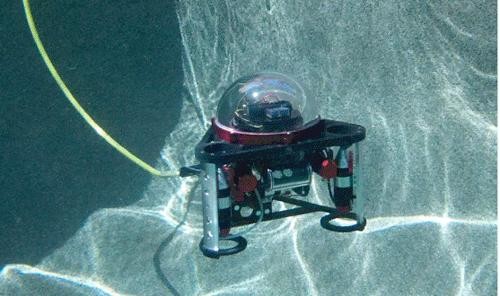Last summer, Eduardo Moreno began restructuring the world of underwater robotics.
Bolstered by the support of the Ronald E. McNair Summer Research Program and pushed by the abrupt departure of his assigned mentor, the senior studying mechanical and electrical engineering began the brainstorming process that eventually lead to the Autonomous Cooperative Underwater Robotic Vehicle, or A-CURV.
Underwater robots are utilized for a variety of tasks, including environmental and scientific data gathering, inspection and assembly of submarine facilities and equipment, Moreno said.
Moreno’s new brand of robot will be low-cost and could conceivably administer underwater services to the Navy, film crews, the Department of Homeland Security and rescue missions. Moreno has already showcased his work at a number of venues, including stops in Anaheim, Calif., and New Orleans.
The A-CURV could also come in handy when cleaning up catastrophes.
“”Recently, we witnessed the British Petroleum oil spill in the Gulf of Mexico, a large man-made disaster that has devastated the Gulf Coast,”” Moreno said. “”The severe lack of underwater technologies necessary to stop the disaster became apparent to the world.””
Ninety percent of the parts and raw material were ordered online, some segments being outsourced from Mexico, Moreno said. The first prototype cost roughly $8,000 and to follow through with the project (a stipend to work full time, pay for hardware and software costs, etc.) Moreno estimated he would need a minimum of $40,000. Although he’s received help from several donors and organizations, about 75 percent of the project has been paid out of pocket with Moreno’s scholarship money.
“”After the summer ended, I realized how large the scope was of this research project and knew that I was in need of a team,”” Moreno said.
He drafted a letter to the College of Engineering asking for sponsorship of a senior design capstone project. He’s now leading and sponsoring a five-man research team of multidisciplinary engineers.
Two ranks of robots carry the monopoly on underwater robotics, the remotely operated vehicle and the autonomous underwater vehicle. The core difference is that the former is remote-controlled and on-board computers handle the latter. The remote-operated vehicle is limited in areas of speed and area inspection while the autonomous underwater vehicle lacks the same precision and does not have the ability to provide live video feedback.
Moreno said he believes his robot can accomplish all the tasks of both these types, and more.
The A-CURV will be an underwater network consisting of several modules; each shaped in the form of an isosceles triangle, capable of coming together and morphing into an array of complex geometric shapes. Advantages of a large and connected structure are enhanced stability in the water, more thrusters that can retrieve and manipulate larger loads and optimizing energy usage.
“”The reconfigurable aspect of the design will provide unique capabilities and flexibility for underwater missions,”” said Ricardo Sanfelice, an assistant professor of aerospace and mechanical engineering and one of Moreno’s mentors.
Each module will be able to navigate independently as well, Moreno said. The structure could intentionally break up at any time, allowing individual pieces to take off and perform tasks on their own. Modules will pack an array of functions including gripping, navigation, temperature reading and specimen storage.
The A-CURV’s design may have ripple effects outside of the water as well. Moreno said the modular and cooperative qualities of the A-CURV will be developed for other terrains and could be applied to land or aerial vehicle control systems.
Moving forward, Moreno said he hopes to gain more sponsors, build another team, acquire more knowledge in areas of programming and electronics, visit marine engineering industries and see the project through to completion.
Maria Teresa Velez, director of the McNair Achievement Program and associate dean of the Graduate College, said Moreno’s strong and positive impact on the McNair Achievement Program’s reputation would be felt for years to come.
The McNair Achievement Program began in 2003 through a grant from the U.S. Department of Education. It prepares top undergraduates that are first generation and low-income for graduate school by way of academic resources and opportunities.
“”The project is a testimony that even as a student, one can pursue activities beyond the outlined academic program,”” Moreno said.









